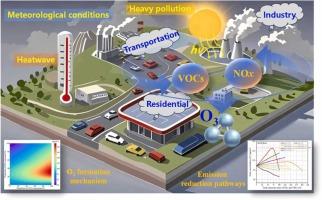Scenario-dependent O3 driver identification and formation responses to VOCs/NOx emission reduction pathways from integrated and sectoral sources in the Beijing-Tianjin-Hebei region, China
IF 11.3
1区 环境科学与生态学
Q1 ENGINEERING, ENVIRONMENTAL
引用次数: 0
Abstract
Persistent surface ozone (O3) in China's Beijing-Tianjin-Hebei region, driven by complex meteorology-precursor interactions, has become a critical air quality crisis. A longstanding challenge in O3 pollution mitigation is identifying drivers of O3 formation and its response to precursor emissions. Using explainable ensemble machine learning, scenario-based modeling and empirical kinetic modeling approach, we quantified O3 formation drivers and evaluated scenario-dependent responses to integrated/sectoral precursor emission reductions across multiple dynamic scenarios. We demonstrate that temperature, solar radiation, and nitrogen dioxide dominate O3 formation across pollution levels. Meteorological conditions for O3 dispersion varied significantly between 2013–2023, with 2021/2023 representing the most favorable/unfavorable years, highlighting strong interannual variability. Spatiotemporal O3-precursor sensitivity exhibited volatile organic compound (VOC)-limited dominance, modulated by dynamic meteorology and pollution levels. While Only-VOCs reductions significantly decreased O3, they have inevitable limitations. VOCs/nitrogen oxides (NOx) = 3:1 pathways enhanced O3 mitigation in Beijing and Shijiazhuang but remained suboptimally efficient. Notably, deepening NOx reductions promoted a shift toward NOx-limited regimes, further improving the efficiency of O3 decrease. Extreme meteorology and heavy pollution increased O3 reduction potential compared to baseline scenarios, with industrial VOCs control proving most effective for sectoral interventions. These findings inform scenario-specific precursor emission policies to address severe O3 pollution.

基于情景的京津冀地区O3驱动因素识别及VOCs/NOx减排路径的形成响应
在复杂的气象前兆相互作用下,中国京津冀地区持续存在的地表臭氧(O3)已成为严重的空气质量危机。减缓臭氧污染的一个长期挑战是确定臭氧形成的驱动因素及其对前体排放的反应。利用可解释的集成机器学习、基于场景的建模和经验动力学建模方法,我们量化了O3地层驱动因素,并评估了多个动态场景下对综合/部门前驱体减排的情景相关响应。我们证明了温度、太阳辐射和二氧化氮在不同污染水平的O3形成中起主导作用。2013-2023年O3弥散的气象条件变化显著,其中最有利/最不利年份为2021/2023年,年际变异性强。臭氧前体的时空敏感性表现为挥发性有机化合物(VOC)有限的优势,受动态气象和污染水平的调节。虽然纯挥发性有机化合物的减少显著降低了O3,但它们也有不可避免的局限性。在北京和石家庄,VOCs/氮氧化物(NOx) = 3:1的减排途径增强了O3的减排效果,但仍然不是最优的。值得注意的是,氮氧化物的进一步减少促进了氮氧化物限制机制的转变,进一步提高了O3的降低效率。与基线情景相比,极端气象和重污染增加了O3减排潜力,工业VOCs控制被证明是部门干预措施中最有效的。这些发现为针对具体情景的前体排放政策提供了信息,以应对严重的臭氧污染。
本文章由计算机程序翻译,如有差异,请以英文原文为准。
求助全文
约1分钟内获得全文
求助全文
来源期刊

Journal of Hazardous Materials
工程技术-工程:环境
CiteScore
25.40
自引率
5.90%
发文量
3059
审稿时长
58 days
期刊介绍:
The Journal of Hazardous Materials serves as a global platform for promoting cutting-edge research in the field of Environmental Science and Engineering. Our publication features a wide range of articles, including full-length research papers, review articles, and perspectives, with the aim of enhancing our understanding of the dangers and risks associated with various materials concerning public health and the environment. It is important to note that the term "environmental contaminants" refers specifically to substances that pose hazardous effects through contamination, while excluding those that do not have such impacts on the environment or human health. Moreover, we emphasize the distinction between wastes and hazardous materials in order to provide further clarity on the scope of the journal. We have a keen interest in exploring specific compounds and microbial agents that have adverse effects on the environment.
 求助内容:
求助内容: 应助结果提醒方式:
应助结果提醒方式:


